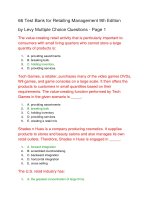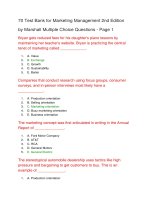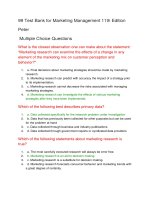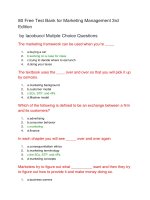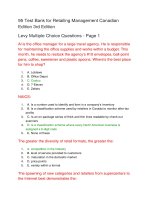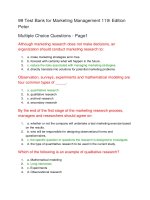105 test bank for effective management 6th edition chuck williams
Bạn đang xem bản rút gọn của tài liệu. Xem và tải ngay bản đầy đủ của tài liệu tại đây (199.2 KB, 37 trang )
Test Bank for Effective Management 6th Edition Chuck
Williams
31 Test Bank True – False Questions
15 Test Bank Free Text Questions
69 Test Bank Multiple Choice Questions
69 Free Test Bank for Effective Management 6th
Edition Chuck Williams Multiple Choice Questions Page 1
Which of the following is NOT a potential legal risk associated with
traditional managerial decisions like recruiting, hiring, and firing
employees?
1.
a.negligent supervision
2.
b.invasion of privacy
3.
c.product liability
4.
d.defamation
5.
e.a charge of emotional distress
In terms of external organizational environments, the ____ environment
affects all organizations while the ____ environment is unique to each
company.
1.
a.global; national
2.
b.customer-driven; production-driven
3.
c.general; specific
4.
d.informal; formal
5.
e.specific; general
What are the two types of external organizational environments?
1.
a.general and the specific
2.
b.public and private
3.
c.global and the national
4.
d.organizational and the interpersonal
5.
e.market-specific and the product-specific
____ is the degree to which an organization's external environment has an
abundance or scarcity of critical organizational resources.
1.
a.Environmental complexity
2.
b.Environmental capacity
3.
c.Differentiation opportunity
4.
d.Environmental dynamism
5.
e.Resource scarcity
Which of the following companies is most likely operating in a dynamic
environment?
1.
a.a video game manufacturer
2.
b.a bakery
3.
c.a brewery, winery, or distillery in the liquor industry
4.
d.a manufacturer of pet food
5.
e.a cereal manufacturer
Tourism was not the only travel-associated industry that was visibly hurt
by what happened on 9/11. People decided to vacation at home and sales
of luggage and similar travel gear decreased significantly. Sales of home
swimming pools increased. This decision to stay at home reflects a
change in attitudes toward the perceived safety of long-distance traveling.
This is an example of a change in the ____ component of the general
environment.
1.
a.technological
2.
b.socio-cultural
3.
c.economic
4.
d.competitive
5.
e.geographic
According to the ____theory, companies go through long, simple periods
of environmental stability, followed by short, complex periods of dynamic,
fundamental environmental change, finishing with a return to
environmental stability.
1.
a.environmental change theory
2.
b.theory of environmental dynamics
3.
c.punctuated equilibrium theory
4.
d.theory of resource scarcity
5.
e.environmental cycle
The ____ consists of the economy and the technological, socio-cultural,
and political/legal trends that indirectly affect all organizations.
1.
a.economic environment
2.
b.specific environment
3.
c.general environment
4.
d.indirect environment
5.
e.direct environment
Which of the following is the LEAST aggressive approach likely to be used
by an advocacy group?
1.
a.public communications
2.
b.media advocacy
3.
c.product boycotts
4.
d.class action lawsuits
5.
e.picketing
Fear of a lawsuit prevents many employers from giving totally honest
recommendations to former employees. This reflects a change in the ____
component of the general environment.
1.
a.technological
2.
b.social
3.
c.economic
4.
d.political/legal
5.
e.demographic
Two homebuilders are building homes in nearby subdivisions. One is
offering 2,500-square-foot homes with two-acre yards. The other is
offering a similarly sized house with quarter-acre yards. The builder
offering the smaller lots cannot keep up with demand. The builder offering
the larger lots has several unsold houses. The builder with the larger lots
could use ____ to determine why his homes are not selling.
1.
a.proactive customer monitoring
2.
b.consumer confidence forecasts
3.
c.demographic information
4.
d.reactive customer monitoring
5.
e.a competitive location study
Which of the following is NOT a dimension of the political/legal
component of the general environment that governs and regulates
business behavior?
1.
a.legislation
2.
b.competitive products
3.
c.court decisions
4.
d.regulation
5.
e.customer-initiated lawsuits
____ is used to refer to a company's practice of identifying and
addressing customer trends and problems after they occur.
1.
a.Consumer confidence forecasts
2.
b.Competitive analysis
3.
c.Reactive customer monitoring
4.
d.Proactive customer monitoring
5.
e.Continuous data mining
Companies doing a competitive analysis typically err by ____.
1.
a.doing an incomplete job of identifying competitors
2.
b.overestimating their competition
3.
c.ignoring proactive monitoring
4.
d.relying on competitive intelligence
5.
e.doing all of these
____ involves deciding who your competitors are, anticipating
competitors' moves, and determining competitors' strengths and
weaknesses.
1.
a.Competitive mapping
2.
b.A market audit
3.
c.A SWOT analysis
4.
d.A proactive strategy
5.
e.A competitive analysis
Consider a hamburger fast-food chain that began operations prior to
World War II. In which of the following would have been part of its specific
environment after the start of World War II?
1.
a.other fast-food restaurants that sell hamburgers
2.
b.its customers who eat burgers at least once a week
3.
c.the meat packing company that supplied its beef
4.
d.government-mandated beef rationing as a result of World War II
5.
e.all of these
Suppose that a Mexican car manufacturer wants to export cars to
Guatemala. The fact that the distribution of income within Guatemala is
highly unequal and that about 75 percent of the population is below the
poverty line would be a(n) ____ component in the manufacturer’s general
environment.
1.
a.technological
2.
b.socio-cultural
3.
c.economic
4.
d.political/legal
5.
e.demographic
Which of the following is a component of Coca-Cola's specific
environment and will directly influence how it does business?
1.
a.Pepsi-Cola
2.
b.laws concerning sanitation
3.
c.inflation
4.
d.the increased popularity of energy drinks
5.
e.the development of vending machines that accept debit cards
Which of the following is a component of a book publisher's general
environment and will indirectly influence how it does business?
1.
a.other book publishing companies
2.
b.pornography laws
3.
c.an advocacy group supporting free books for children
4.
d.a trend toward less leisure time
5.
e.paper and ink suppliers
In terms of environmental complexity, ____ environments have few
environmental factors, whereas ____ environments have many
environmental factors.
1.
a.non-competitive; competitive
2.
b.simple; complex
3.
c.stable; dynamic
4.
d.scarce; abundant
5.
e.market-oriented; product-oriented
More premature babies than ever before are surviving due to
improvements in medical knowledge and care. This improved survival rate
can be attributed to the ____ component of hospitals.
1.
a.technological
2.
b.socio-cultural
3.
c.economic
4.
d.political/legal
5.
e.demographic
A fast-food restaurant chain is famous for its small, square hamburgers.
Which of the following would be a component of its general environment?
1.
a.meat processing companies that provide its ground beef
2.
b.consumers who will drive miles out of their way to eat a burger
3.
c.boycotts by the Chicago organization of People for the Ethical Treatment of
Animals (PETA)
4.
d.local zoning laws that designate the appropriate distance from the street for a
restaurant to be located
5.
e.inflation
A company facing a simple environment would ____.
1.
a.most likely be in the first stage of the environmental cycle
2.
b.exhibit proof of the punctuated equilibrium theory
3.
c.be unable to succeed due to lack of innovation
4.
d.be influenced by only factors in its specific environment
5.
e.have few external factors in the environment that affect it
Over the past 20 years, which of the following is an industry that has
experienced both the stable and dynamic environments predicted by
punctuated equilibrium theory?
1.
a.the airline industry
2.
b.the baking industry
3.
c.the video game industry
4.
d.the breakfast cereal industry
5.
e.the landscaping industry
Environmental ____ is affected by environmental complexity, change, and
resources.
1.
a.uncertainty
2.
b.differentiation
3.
c.difficulty
4.
d.essence
5.
e.entrepreneurship
Managers often prefer to use business confidence indices ____.
1.
a.to identify socio-cultural trends
2.
b.as predictors of future economic activity when making business decisions
3.
c.which are based on intuition and experience
4.
d.to encourage customers to make long-term buying decisions
5.
e.to improve consumer confidence forecasts
A fast-food restaurant chain is famous for its small, square hamburgers.
Which of the following would be a component of its socio-cultural
environment?
1.
a.a period of business prosperity
2.
b.the development of fully automated drive-through windows
3.
c.a price war with Burger King and McDonald's
4.
d.the fact most consumers prefer eating out rather than at home
5.
e.regulations passed by the Food & Drug Administration
Which of the following is a component of the specific environment that
would directly influence a restaurant's day-to-day operation?
1.
a.its regular customers
2.
b.GNP
3.
c.a trend toward eating less fat
4.
d.more rigid enforcement of OSHA laws
5.
e.all of these
The manager of a company that produces a soy-based sausage wants to
conduct a competitive analysis. During this competitive analysis, he
should look at ____.
1.
a.companies that produce other brands of pork-based sausage
2.
b.Morningstar, a company that has a complete line of soy-based products
3.
c.companies that produce other forms of breakfast meats like bacon
4.
d.individuals who make their own sausage
5.
e.The manager should consider all of the listed factors.
Changes in any sector of the general environment ____.
1.
2.
a.will typically not impact most organizations
b.tend to slow down how quickly an organization moves through the environmental
cycle
3.
c.inhibit the innovation process
4.
d.influence customers first and then suppliers
5.
e.will eventually affect most organizations.
In a very strong economy, where the demand for qualified job applicants
exceeds the supply, the environmental characteristic of ____ is likely to be
particularly salient for many companies.
1.
a.environmental complexity
2.
b.environmental change
3.
c.resource scarcity
4.
d.environmental uncertainty
5.
e.environmental risk
Legislation concerning the disposal of biological wastes, the development
of more sophisticated imaging machines, and longer patient life spans
would all be part of the ____ for a public hospital.
1.
a.internal environment
2.
b.specific environment
3.
c.socio-cultural environment
4.
d.general environment
5.
e.environmental differentiation
All events outside a company that have the potential to influence or affect
it occur in the ____ environment.
1.
a.specific
2.
b.external
3.
c.formal
4.
d.potential
5.
e.national
Two homebuilders are building homes in nearby subdivisions. One is
offering 2,500-square-foot homes with two-acre yards. The other is
offering a similar size of house with quarter-acre yards. The builder
offering the smaller lots cannot keep up with demand. The builder offering
the larger lots has several unsold houses. The builder with the smaller
lots most likely used ____ to determine what homebuyers desired.
1.
a.reactive customer monitoring
2.
b.proactive customer monitoring
3.
c.competitive analysis
4.
d.environmental munificence
5.
e.consumer confidence forecasts
Technology is the ____ used to transform inputs (raw materials,
information, etc.) into outputs (products or services).
1.
a.knowledge, tools, and techniques
2.
b.knowledge and machinery
3.
c.plans and machinery
4.
d.tools and techniques
5.
e.strategy and tactics
69 Free Test Bank for Effective Management 6th
Edition Chuck Williams Multiple Choice Questions Page 2
Which of the following is one of the steps in the process that managers
use to make sense of their changing environments?
1.
a.perceptual re-engagement
2.
b.environmental laddering
3.
c.acting on threats and opportunities
4.
d.creating strategic windows
5.
e.behavioristic relations
After an organization's founders are gone, the organization can use ____
to sustain its organizational culture.
1.
a.industry associations
2.
b.organizational heroes
3.
c.organizational structure
4.
d.organizational maps
5.
e.reciprocal formalization
When using ____techniques to change organizational culture, the key to
success is to choose behaviors that are central to and symbolic of the old
culture that is changing and the new culture you want to create.
1.
a.attitudinal motivation and conditioned learning
2.
b.behavioral substitution and behavioral addition
3.
c.conditioned and classical learning
4.
d.negative and positive reinforcements
5.
e.organizational stories and heroes
The first step managers use to make sense of their changing
environments is ____.
1.
a.environmental scanning
2.
b.perceptual re-engagement
3.
c.modifying budgets
4.
d.downsizing
5.
e.benchmarking
In setting up his new office, an attorney wanted furnishings that were
elegant and that would make him look successful. He wanted thick, plush
carpeting in his office, but federal regulations state that his office must be
wheelchair accessible because it is a public area. Wheelchairs do not
maneuver well in thick carpeting. The building inspector had him remove
the expensive carpeting and replace it with a carpet that did allow for
wheelchair maneuverability. This is an example of how the ____
component of
1.
a.socio-cultural
2.
b.economic
3.
c.political/legal
4.
d.supplier
5.
e.industry regulation
When Susan started work at Henderson Textile Co., she was amazed at its
employees who would take 30-minute restroom breaks, leave for the day
at 2 p.m., and generally belittle the company's management. Such
employees' actions most likely developed over time as a result of a faulty
____.
1.
a.general environment
2.
b.benchmark
3.
c.response to an opportunity
4.
d.organizational culture
5.
e.formalization strategy
Managers can use behavioral addition and behavioral substitution to
____.
1.
a.create benchmarks
2.
b.assess the threats and opportunities in the internal environment
3.
c.develop new products
4.
d.locate new markets for existing products
5.
e.modify corporate culture
The Edmonton Oilers ice hockey team develops a sense of history for its
current players by raising banners showing its success - five
championships - and the retired numbers of great players from the past in
its stadium and locker room. What tactics for maintaining organizational
culture are the Edmonton Oilers using?
1.
a.organizational complexity and consistency
2.
b.organizational benchmarking
3.
c.cultural laddering
4.
d.organizational stories and organizational heroes
5.
e.behavioral addition and behavioral substitution
Organizations use behavioral addition, behavioral substitution, and ____
to change their organizational culture.
1.
a.media advocacy
2.
b.visible artifacts
3.
c.psychological counseling
4.
d.affective stores
5.
e.incremental valences
In order to change an organizational culture, top management can
persuade other managers and employees to perform a new behavior in
place of an older one. This technique is called ____.
1.
a.behavioral iteration
2.
b.behavioral substitution
3.
c.behavioral subtraction
4.
d.organizational acculturation
5.
e.replacement behavior
Which of the following approaches will guarantee the successful change
of an organizational culture?
1.
a.employee munificence
2.
b.perceptual substitution
3.
c.the recognition of new organizational heroes
4.
d.new organizational stories
5.
e.None of the choices can guarantee successful organizational change.
Small manufacturers are successful often because Wal-Mart agrees to
carry their products. If Wal-Mart does not like a price increase, it often will
refuse to do business with the manufacturer. At this point, many small
manufacturers will offer price reductions because they fear failure if they
lose the Wal-Mart account. The relationship between these small
manufacturers and Wal-Mart can be described as ____.
1.
a.buyer dependent
2.
b.relationship-based
3.
c.transformational
4.
d.supplier dependent
5.
e.none of these
The creation of Ingram Distribution allows booksellers to streamline the
ordering and return procedures of their books. Ingram made all the books
bookstore owners wanted available in one centralized warehouse. Many
new bookstore owners would be unwilling and/or unable to return to the
method of ordering books from the individual publishers. This is an
example of the creation of ____.
1.
a.high buyer dependence on a supplier
2.
b.pure competition
3.
c.transactional freedom
4.
d.high supplier dependence on a buyer
5.
e.none of these
A mace is commonly used at a university or college convocation
ceremony. The mace was originally a weapon, then became the symbol of
government, and now has become the symbol of authority of the
institution to grant diplomas or degrees. In terms of organizational
culture, the mace is an example of a(n) ____.
1.
a.visible artifact
2.
b.iconic representation
3.
c.organizational metaphor
4.
d.organizational allegory
5.
e.imbued legend
Kodak makes digital cameras and paper for prints. Kodak would view the
ubiquity of digital cameras as a(n) ____ in its external environment if it
considered how digital cameras affect sales of cameras that use film. On
the other hand, Kodak would view the growing popularity of digital
cameras as a(n) ____ in its external environment if it considered the
amount of Kodak processing paper used in printing pictures made by
digital cameras.
1.
a.strength; weakness
2.
b.risk; certainty
3.
c.opportunity; threat
4.
d.certainty; risk
5.
e.threat; opportunity
____ is a tactic in which an advocacy group actively tries to convince
consumers not to purchase a company's product or service.
1.
a.Lobbying
2.
b.Public communications
3.
c.Media advocacy
4.
d.Product boycott
5.
e.Market denigration
A fast-food restaurant chain is famous for its small, square hamburgers.
Which of the following would be an industry regulation component of its
specific environment?
1.
a.an increase in the prime lending rate
2.
b.local health inspectors
3.
c.class-action suits against all fast-food restaurants
4.
d.inflation
5.
e.all of these
Typically the most important factor in the relationship between companies
and their suppliers is ____.
1.
a.how dependent they are on each other
2.
b.how much they know about each other
3.
c.how compatible their organizational cultures are
4.
d.the type of product being manufactured
5.
e.all of these
Which of the following statements about corporate cultures is true?
1.
a.Corporate cultures are dynamic creations that respond positively to change.
2.
b.Corporate culture are unaffected by changes in perks, office layouts, or work
relationships.
3.
c.Corporate cultures are very difficult to change.
4.
d.Any manager who wants to modify a corporate culture must follow the cultural
change plan, which begins with employee input and ends with behavioral addition
and/or substitution.
5.
e.Corporate culture change is significantly easier with behavioral addition than
with behavioral subtraction.
An increase in ____ can lead to opportunistic behavior in which one party
benefits at the expense of the other.
1.
a.managerial commitment
2.
b.buyer dependence
3.
c.industry regulation
4.
d.advocacy group activities
5.
e.consumer confidence indicators
A high degree of buyer or seller dependence can lead to ____ in which
one party benefits at the expense of the other.
1.
a.relationship behavior
2.
b.transactional behavior
3.
c.behavioral monogamy
4.
d.relational monopoly
5.
e.opportunistic behavior
The term ____ refers to the events and trends inside an organization that
affect management, employees, and the organizational culture.
1.
a.managerial environment
2.
b.internal environment
3.
c.industry environment
4.
d.general environment
5.
e.organizational structure
____ is a primary source of organizational culture.
1.
a.The company's founder
2.
b.The organization's competitive strategy
3.
c.The industry in which the organization operates
4.
d.Suppliers
5.
e.Customers
One of the difficulties encountered in recent mergers has been the
inability of employees in the two existing organizational cultures to
operate harmoniously. In other words, merging organizational cultures
often lack the ____ that would increase the likelihood of a merger's
success.
1.
a.responsiveness
2.
b.adaptability
3.
c.involvement
4.
d.consistency
5.
e.validity
According to a book by a Harvard Business School professor, some
organizational cultures simply cannot meet the challenges posed by
innovation and must respond to threats from new technologies by
building outside ventures. Digital Equipment is described as having one
of those organizational cultures. The company squandered the
opportunities presented by the PC revolution even though it was well
equipped to build cheap PCs. The company did not have ____.
1.
a.adaptability
2.
b.synergy
3.
c.a formula for success laddering
4.
d.knowledge management
5.
e.comprehension
____ is the process of having managers and employees perform new
behaviors that are central to and symbolic of the new organizational
culture a company wants to create.
1.
a.Relationship transformation
2.
b.Behavioral substitution
3.
c.Partnering
4.
d.Attitudinal modification
5.
e.Behavioral addition
An emphasis on ____ is likely to decrease opportunistic behavior but will
never completely eliminate it.
1.
a.buyer dependence
2.
b.supplier dependence
3.
c.industry regulation
4.
d.relationship behavior
5.
e.competitive advocacy
Which of the following would be an example of a visible artifact for an
organization that is merging with a large international firm?
1.
a.personal parking spaces for all salespeople
2.
b.a private company dining room
3.
c.traditional offices
4.
d.end-of-year bonuses
5.
e.all of these
The ____ is the set of key values, beliefs, and attitudes shared by
members of an organization.
1.
a.industry code of ethics
2.
b.internal environment
3.
c.organizational culture
4.
d.organizational strategy
5.
e.organizational vision
When Samsonite purchased American Tourister, one of the first things the
new management did was to eliminate the American Tourister Gorilla
mascot (which had appeared in all American Tourister ads for years and
which represented the quality construction of American Tourister
luggage). The gorilla had been a symbol of quality and commitment for
American Tourister employees. The executive order to remove the gorilla
posters from the walls of offices and factories was one of the means
Samsonite used to change
1.
a.visible artifacts
2.
b.iconic representations
3.
c.organizational metaphors
4.
d.organizational allegories
5.
e.imbued technology
One of the problems with many of the dot-com companies that failed in
the mid-1990s was a lower and middle management adherence to
innovation and an expectation that work would be fun while top
management envisioned the company being profitable and the elimination
of unnecessary expenses. These companies lacked ____ in their
organizational cultures.
1.
a.empathy
2.
b.formalization
3.
c.consistency
4.
d.broad spans of management
5.
e.responsiveness
Milsand Corp. used office cubicles for its employees. Employees were not
allowed to personalize their cubicles. If Milsand wanted to change its
organizational culture, it could begin by ____.
1.
a.creating a new human resources department
2.
b.hiring a cultural ombudsman
3.
c.adhering to affirmative action regulations
4.
d.allowing employees to personalize their cubicles
5.
e.giving everyone raises
Which of the following is a characteristic of successful organizational
cultures?
1.
a.adaptability
2.
b.consistency
3.
c.involvement
4.
d.a clear mission
5.
e.all of these
Advocacy groups use a variety of tactics to convince businesses to
comply with the group's stand on issues. Which of the following advocacy
group tactics would be most likely to cause a business to fail?
1.
a.media advocacy
2.
b.product boycotts
3.
c.public communications
4.
d.requiring a business license
5.
e.lobbying
31 Free Test Bank for Effective Management 6th
Edition Chuck Williams True - False Questions
The two kinds of external organizational environments are the general
environment and the specific environment.
1.
True
2.
False
Organizational culture refers to the set of key values, beliefs, and attitudes
shared by organizational members.
1.
True
2.
False
A decrease in either buyer dependence or supplier dependence can lead
to opportunistic behavior.
1.
True
2.
False
External environments are the forces and events outside a company that
have the potential to influence or affect it.
1.
True
2.
False
After the company founders are gone, stories and heroes can help to
sustain the founder's values, attitudes, and beliefs in the organizational
culture.
1.
True
2.
False
Environmental complexity refers to the degree of change in the external
factors that affect organizations.
1.
True
2.
False
The general segment of a company’s external environment consists of the
economy and the technological, socio-cultural, and political/legal trends
that indirectly affect all organizations.
1.
True
2.
False
Successful organizational cultures seem to be based solely upon
consistency (i.e., "strength" of the organizational culture).
1.
True
2.
False
Managers often do a poor job of identifying potential competitors.
1.
True
2.
False
The general segment of a company’s external environment is unique to
each firm's industry and directly affects the way it conducts day-to-day
business.
1.
True
2.
False
According to its rate of environmental change, an organization's
environment can be either stable or dynamic, but not both.
1.
True
2.
False
When used together, the combination of behavioral substitution,
behavioral addition, and changing visible artifacts is extremely likely to
achieve the desired changes in organizational culture.
1.
True
2.
False
Proactive customer monitoring is defined as identifying and addressing
customer trends and problems after they occur.
1.
True
2.
False
